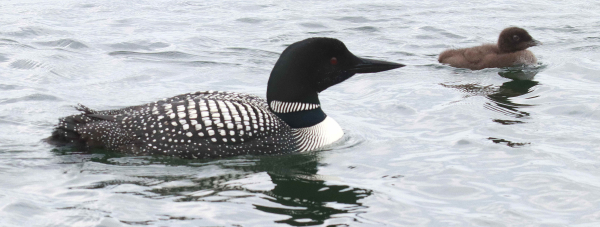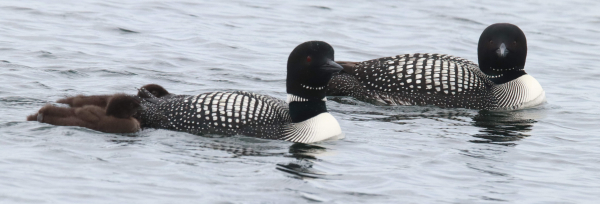During the past few summers, photographing Common Loons in northern Minnesota has been an especially enjoyable part of the season, and it’s something I have enjoyed sharing with longtime friends, Andy, Linda, Dwight, and Pat. Loons are very special birds, and the more you are around them the more you appreciate their importance to any Northwoods outing, especially when you can get close to them (without getting too close). For the most part getting close enough to photograph loons requires a boat, and the best example is Andy’s luxury loon pontoon, partly because he is a seasoned pontoon pilot when we have photographed loons, mergansers, Ospreys, Bald Eagles, Belted Kingfishers, Great Blue Herons, and a few other species encountered on lake waters.

After the initial surprise of seeing such an early hatchling duo, it was fun to take some intimate photos of each of the recent hatchlings interacting with the lone adult (550mm zoom lens, f-10 aperture, 1/2500 shutter speed, 1600 ISO).
As described in my Editor Afield article in this issue, I enjoyed a fast-paced circle trip that emphasized family, friends, birding, and live music in big city and rural areas of Minnesota and North Dakota. In the midst of that energizing tour I enjoyed an overnight stay and morning loon photography float with Andy on the Pelican Lakes near the town of Detroit Lakes. This time I didn’t plan my visit around a period of ample sunshine and slight wind, which is usually a paramount consideration for successful loon photography, primarily because it was far too early in the season to photograph loon families.
Past experience showed that the eggs of nesting Common Loons don’t begin to hatch until the last week of June in that area, with the first week of July being a better bet. With an average incubation period of 27 days, that positions nest building during late May or early June, so at this early date (June 5th), we were left with just having some fun on the pontoon, checking for loons on territory and seeing what other birds were present during my earliest “summer” visit to Andy’s new home. After a light sprinkle, Andy and I headed into the overcast morning, the only boat on the water, barely making a ripple as we scanned the perimeter of the lake.
Our first lake didn’t offer much avian action, and just as we were about to cruise to the larger of the Pelican Lakes, I spied a single loon just off the left side of the pontoon, and we stopped for some first of the year photos. After all, it was my first Common Loon sighting of the year, and how could I pass up a chance to take a few initial photographs, gray sky or not. The loon was elegant and relaxed and it was a delight to float nearby. Then it was on to the next lake, just to see what we might find, and in just a few moments we were legitimately astonished to see an adult Common Loon with 2 new downy hatchlings floating next to it! What?!

The downy hatchlings soon relaxed into napping mode while floating near the adult. The lack of sunlight warranted changing the ISO from my usual 800 setting to 1600, which also permitted using a wider f-10 aperture to ensure all the birds were within the focal area, while maintaining a fast shutter speed to ensure sharp photographs (550mm zoom lens, f-10 aperture, 1/2500 shutter speed, 1600 ISO).
Sure enough, there they were, and we were especially careful not to get too close. As soon as Andy turned the motor off the young loons began napping near the beautiful adult. A couple minutes later, a hatchling approached the adult and moments later Andy saw the other adult approaching. The presumed male dived and swam underwater most of the way to join the family group, which also seemed to prompt a slow move closer to shore. In the process, they swam very close to the loon pontoon, giving us close views and photo ops of the downy hatchlings with the adults. It looked like the young loons were about 3 to 5 days old, which means the adults probably began nesting the first week of May, a month before we would have expected them to begin. Loons are such noble birds and they show that as they grace northern lakes.
Cloudy Tech
Even though we had excellent photo subjects, the sky was gray and the sun didn’t shine, so I expected the photographs to be more documentary than publication quality. Knowing from the start that this was more of an exploratory cruise than a photo event, the lack of sunlight and blue water was not the only limiting factor. Unknown to me was the fact that my camera was having technical difficulties, and that fact wasn’t revealed until I reviewed the photos at home the following day.
Especially when we were in the company of the first loon, whose mate was probably incubating on a nearby nest, at times it seemed that my camera wasn’t in sharp focus. I noticed that with the loon family at times too. Seeing the many out of focus photographs during the loon photo review, I checked the focus point on my camera. Lately I have been using a single centered point of focus in the photo frame of the camera, but the problem was clear when I saw the focus point was far to the left side of the photo frame and elevated above the center line. How the heck did that happen?

Photographed June 5th, this was the earliest date we have seen hatchlings, which probably hatched 3 to 5 days earlier. This was also the first pair of “twins” we have seen in the area (150mm zoom lens, f-10 aperture, 1/1000 shutter speed, 1600 ISO).
Frankly though, I find that this kind of tech change happens all too often with today’s cameras. During transport, or while photographing, or as my camera lies on the car seat next to me – a little nudge or 2 or 3 in the wrong place and whamo, something gets tweaked a little or a lot, and in this case it was the focus point. Or maybe it’s the work of gremlins. The end result was a very off-center focal point that I was unaware of, which created a lot of out of focus photographs. Under those conditions, the photos of members of the loon family turned out in sharp focus with greater frequency, because one or more of the loons was often closer to the focal point or on that focal plane. Obviously, I quickly grabbed my camera and changed the focal point back to the center point.
Similarly, the next day an even worse situation came up: When I encountered a pair of Marbled Godwits along a very rural road, I stepped out of my car and photographed from a somewhat crouched behind my car as one of the godwits walked through an area where lush green grass reached up to its belly. It was really pretty and the godwit was literally posing, turning this way and that, stretching its neck down, then up again; and after taking what I thought was a few nice photos, I retreated to my car and down the road. A few moments later, I was inquisitive to see how the photos turned out, so replayed the godwit photos on the LCD screen on the back of my camera. What I saw was shocking.

While we always keep a safe distance away when photographing loons, the birds almost always move a little closer as we float quietly on the pontoon (400mm zoom lens, f-10 aperture, 1/1600 shutter speed, 1600 ISO).
The photos were so overexposed some were a blank white, while others showed an outline of the godwit with the rest of the image whited out – the photos were horribly overexposed. Luckily, I checked the photos almost immediately, and when I checked the settings it was obvious that somehow the Mode Dial on the top of the camera had been inadvertently turned from my usual Av (aperture priority) mode to the M (manual) setting. Considering I caught this tech problem quickly, it was easy to turn the dial back to Av, and although the Marbled Godwit photos would have been nice, I have occasional opportunities to take similar photos. Even so, it’s another example of how an important camera setting can be inadvertently changed.
The most obvious inadvertent changes I tend to have involve the Exposure Level Indicator, which is a linear scale positioned on the LCD monitor “touch screen.” That touch screen is most often the culprit when I have camera tech problems, which may be due to touching the screen with my cheek while in photographing positions, somehow changing the Exposure scale, or another touch screen setting. Farther down the road, while photographing a singing Yellow Warbler I noticed that my camera wasn’t taking “continuous” photographs when I held the shutter button down for a couple seconds. Instead, it was only taking a single photo, so I immediately re-selected the Continuous photo mode, which was an easy fix.

When the loons swam closest, the photo angle was elevated, providing more of a backside photo angle. Loons really embody the spirit of the Northwoods and add tremendously to any lakes country outings (150mm zoom lens, f-10 aperture, 1/800 shutter speed, 1600 ISO).
That tech problem also probably originated as a result of my cheek pressing against the Touch Screen, so I obviously need to be more aware of my position in relation to my camera, or turn off the touch screen altogether. But it also indicates I need to check my camera and lens settings before I leave my house to make sure I am ready for the next photo opportunity. Even beyond unintentionally changing camera settings, I occasionally change the ISO setting and forget to change it back to my preferred setting. Or I change the regular lens focus position to a close focus setting and forget to change it back for the next day’s more distant photo activities. Anyway, it’s important to double-check obvious settings like that, and maybe even take an initial photo to make sure the focus, lighting, and other features are correct for the imagined photo action to come that day.
Back to the Loons; some photos worked out pretty well, but seeing the many images I deleted, I want to get back in the saddle soon, or at least back on the pontoon. And again, there is something very special about loons that attracts a special group of friends to share our interest in seeing these birds a little closer, a little more often, and enjoying the sense of being at one with the North Woods together. As I say to Andy, “It’s a good thing I don’t live on a lake with a boat handy, because I’d be on the water all the time.” But wouldn’t that actually be a good thing? Enjoy your week!
Article and Photographs by Paul Konrad
Share your bird photos and birding experiences at editorstbw2@gmail.com